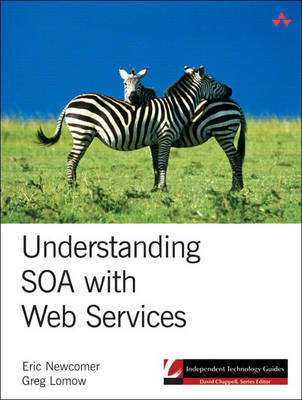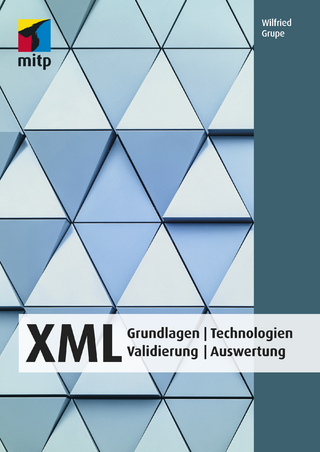
Understanding SOA with Web Services
Addison-Wesley Educational Publishers Inc (Verlag)
978-0-321-18086-5 (ISBN)
- Titel ist leider vergriffen;
keine Neuauflage - Artikel merken
About the Authors In the role of Chief Technology Officer at IONA, Eric Newcomer is responsible for IONA's technology roadmap and direction as relates to standards adoption, architecture, and product design. Eric joined IONA in November 1999 as transaction architect, and most recently served as Vice President of Engineering, Web Services Integration Products. Eric has 26 years experience in the computer industry, including more than 15 years at Digital Equipment Corporation/Compaq Computer, where he held a variety of technical and management positions before receiving a corporate-level technical appointment. Eric received his BA in American Studies from Antioch College, with a minor in computer science. In addition to Understanding Web Services, published in 2002, Eric is co-author of Principles of Transaction Processing, published in 1997 by Morgan Kaufman, and co-author of a chapter called "The Keys to the Highway" in The Future of Software, published in 1995 by MIT Press. Eric is also the author of numerous white papers and articles, co-author and editor of the Structured Transaction Definition Language specification published by X/Open (now The Open Group) in 1994, former member of the Transaction Internet Protocol working group at IETF, former member of the X/Open Distributed Transaction Processing committee that created the XA specification, former chair of the OTS RTF at OMG, and chair of the team that developed the XML Valuetype specification at OMG to map XML to CORBA. He was a charter member of the XML Protocols Working Group at W3C, where he served as an editor of the requirements document that led to SOAP 1.2. He served for nearly two years as an editor of the W3C Web Services Architecture Specification, and most recently served as co-chair and editor of the Web Services Composite Application Framework set of specifications at OASIS. Greg Lomow, Ph.D., is a senior manager and consultant for BearingPoint, Inc. Greg has 12 years of experience as a consultant and enterprise architect working in the financial services, telecom, and federal government sectors designing business applications using service-oriented architecture, developing simulation applications using distributed object technology, and training developers in object-oriented design and programming techniques. He also worked for eight years as a product manager at Jade Simulations, Level 8 Systems, and IONA Technologies responsible for integration, web services, and middleware products. Greg co-authored C++ Frequently Asked Questions published by Addison-Wesley in October 1999 (1st ed.) and again in January 1999 (2nd ed.). He completed his Ph.D. in computer science at the University of Calgary, Canada, in 1988. Greg is an active member of the Web Services Interoperability (WS-I) Organization. © Copyright Pearson Education. All rights reserved.
Preface.
Acknowledgments.
About the Authors.
Introduction.
What's in the Book.
Organization of the Book.
Part I.
Part II.
1. Introduction to SOA with Web Services.
The Service-Oriented Enterprise.
Service-Oriented Development.
Service Abstraction.
Service-Oriented Architecture.
What Are Services?
What Is Service-Oriented Architecture?
Challenges to Adoption.
SOA and Web Services.
Rapid Integration.
Multi-Channel Access.
Occasionally Connected Computing.
Business Process Management.
Extended Web Services Specifications.
Standardization.
Specification Composability.
Metadata Management.
Security.
Reliability and Messaging.
Transactions.
Orchestration.
Summary.
I. SOA AND BUSINESS PROCESS MANAGEMENT CONCEPTS.
2. Overview of Service-Oriented Architecture.
Service-Oriented Business and Government.
Service-Oriented Architecture Concepts.
SOA Processes, Principles, and Tools.
Services.
Line of Business Services.
Reusable Technical Services.
Service Contracts.
Web Services Platform.
Service Requesters and Service Providers.
Approved Products, Technologies, and Facilities.
Service Governance, Processes, Guidelines, Principles, Methods, and Tools.
SOA Governance Policies and Processes.
SOA Principles and Guidelines.
Key Service Characteristics.
Primary Characteristics.
Secondary Characteristics.
SOA Guidelines for Service Requesters.
SOA Guidelines for Legacy Systems and Legacy Services.
Technical Benefits of a Service-Oriented Architecture.
Efficient Development.
More Reuse.
Simplified Maintenance.
Incremental Adoption.
Graceful Evolution.
Service-Oriented Architecture-Business Benefits.
Increased Business Agility.
Better Business Alignment.
Improved Customer Satisfaction.
Reduced Vendor Lock-In and Reduced Switching Costs.
Reduced Integration Costs.
Improved ROI of Existing IT Assets.
Summary.
3. SOA and Web Services.
The Web Services Platform.
Elements of the Web Services Platform.
Web Services Platform Principles.
Service Contracts.
Service Contract Elements.
Documenting and Defining Service Contracts.
Service Contract Principles.
Service Contracts Focus on Service-Level Abstractions.
WSDL and Service Contracts.
WSDL Service Contract Architecture.
Example WSDL Service Contract-Calendar Service.
Service-Level Data Model.
Relationship Between Service-Level Data Models and Internal Data Models.
Reconciling Disparate Data Models Across Different Service Domains.
Using XML-Related Technologies for the Service-Level Data Model and Data Handling.
Service Discovery-Registration and Lookup.
Service-Level Security.
Service-Level Interaction Patterns.
A Quick Look at SOAP and HTTP.
Request/Response Interactions.
Request/Callback Interaction Paradigm.
Asynchronous Store-and-Forward Messaging.
Example Business Scenario Using Request/Response and Asynchronous Messaging
Publish/Subscribe Interaction Paradigm.
Atomic Services and Composite Services.
Generating Proxies and Skeletons from Service Contracts.
Generating Java Classes from Service Contracts.
Generating C# Classes from Service Contracts.
Generating C++ Classes from Service Contracts.
Service-Level Communication and Alternative Transports.
WSDL Extensibility.
SOAP over IBM WebSphere MQ.
SOAP over JMS.
SOAP over CORBA IIOP.
SOAP over Tibco Rendezvous.
A Retrospective on Service-Oriented Architectures.
Overview of Selected Technologies That Have Been Used to Implement SOAs.
Detailed Comparison of SOA Technologies.
Summary.
4. SOA and Web Services for Integration.
Overview of Integration.
Common Business Drivers for Integration.
Common Technical Challenges Faced During Integration.
Requirements That the "Ideal" Integration Solution Must Satisfy.
Integration Can Be Performed at Different Layers of the Technology Stack.
Integration and Interoperability Using XML and Web Services.
Two Approaches for Using XML and Web Services for Integration and Interoperability.
Web Services Integration (WSI).
Service-Oriented Integration (SOI).
Applying SOA and Web Services for Integration-.NET and J2EE Interoperability.
Applying SOA and Web Services for Integration-Service-Enabling Legacy Systems.
Example #1-CICS and IMS.
Example #2-CORBA.
Applying SOA and Web Services for Integration-Enterprise Service Bus Pattern.
Summary-SOA and Web Services for Integration.
5. SOA and Multi-Channel Access.
Business Benefits of SOA and Multi-Channel Access.
Multi-Channel Access Reduces Staffing Costs.
Multi-Channel Access Eliminates Obsolete and Expensive Infrastructure.
Service-Oriented Architecture Reduces Costs and Improves Efficiency.
A Service-Oriented Architecture for Multi-Channel Access.
Architectural Challenges.
Architecture for Multi-Channel Access.
Client/Presentation Tier.
Channel Access Tier.
Communication Infrastructure.
Business Service Access Tier.
Business Service Tier.
Example-SOA for Developing Composite Applications.
Example-SOA for Multi-Channel Access Architecture.
Summary.
6. SOA and Business Process Management.
Basic Business Process Management Concepts.
Business Process Management Systems.
Process Modeling.
Process Execution.
Process Monitoring.
Business Activity Monitoring.
Example Business Process.
Combining BPM, SOA, and Web Services.
Benefits of BPM, SOA, and Web Services.
Defining Atomic and Composite Services.
Orchestration and Choreography Specifications.
Comparing Web Services Orchestration and Choreography.
WS-BPEL.
Choreography Description Language.
Example of Web Services Composition.
Orchestration-Centric Approach.
Choreography-Centric Approach.
Comparing Orchestration-Centric and Choreography-Centric Approaches.
Part I Summary: Benefits of Combining BPM, SOA, and Web Services.
Individual Features and Benefits of BPM, SOA, Web Services, and XML.
Complementary Features and Benefits of BPM, SOA, and Web Services.
II. EXTENDED WEB SERVICES SPECIFICATIONS.
7. Metadata Management.
The Simple Approach to Metadata Management.
Using Plain SOAP and WSDL.
Metadata Specifications.
XML.
WSDL 2.0.
UDDI.
Addressing.
Policy.
WS-Policy.
Web Services Policy Language (WSPL).
WSDL 2.0 Features and Properties.
Comparing the Policy Specifications.
WS-MetadataExchange.
Summary.
8. Web Services Security.
Overarching Concern.
Core Concepts.
Identity.
Authentication.
Digital Signature.
Summary of Challenges, Threats, and Remedies.
Message Interception.
Person in the Middle Attacks.
Spoofing.
Replay Attacks.
Denial-of-Service Attacks.
Securing the Communications Layer.
IP Layer Security.
Transport-Level Security.
Message-Level Security.
The WS-Security Framework.
WS-SecurityPolicy.
WS-Trust.
WS-SecureConversation.
WS-Federation.
Security Assertion Markup Language (SAML).
XACML: Communicating Policy Information.
XML Key Management Specification (XKMS).
Data-Level Security.
XML Encryption.
XML Signature.
Summary.
9. Advanced Messaging.
Reliable Messaging.
Overview.
Concepts and Technologies.
Benefits of Reliable Messaging.
Usage Scenarios for Reliable Messaging.
Web Services Reliable Messaging Specifications.
Comparing Web Services Reliable Messaging and Asynchronous Message Queuing.
Notification.
WS-Eventing.
WS-Notification.
Mobile Workers and Occasionally Connected Computing.
Summary.
10. Transaction Processing.
Overview.
The Transaction Paradigm.
Impact of Web Services on Transactions.
Protocols and Coordination.
Activity.
Context.
Addressing.
Policy.
Coordination.
Protocol Types.
Transaction Specifications.
The Web Services Coordinator.
WS-AtomicTransaction.
WS-BusinessActivity.
WS-Context.
WS-Coordination Framework.
WS-Transaction Management.
Summary.
Bibliography.
Books.
Technology References.
Articles.
Specifications.
General.
Metadata.
Security.
Reliability.
Notification.
Transactions.
Orchestration.
Orchestration Historical References.
Other Resources.
Index.
| Erscheint lt. Verlag | 6.1.2005 |
|---|---|
| Reihe/Serie | Independent Technology Guides |
| Verlagsort | New Jersey |
| Sprache | englisch |
| Maße | 178 x 233 mm |
| Gewicht | 672 g |
| Themenwelt | Mathematik / Informatik ► Informatik ► Netzwerke |
| Informatik ► Programmiersprachen / -werkzeuge ► XML | |
| Mathematik / Informatik ► Informatik ► Web / Internet | |
| Schlagworte | Services Oriented Architecture (SOA) • Web Services |
| ISBN-10 | 0-321-18086-0 / 0321180860 |
| ISBN-13 | 978-0-321-18086-5 / 9780321180865 |
| Zustand | Neuware |
| Haben Sie eine Frage zum Produkt? |
aus dem Bereich
